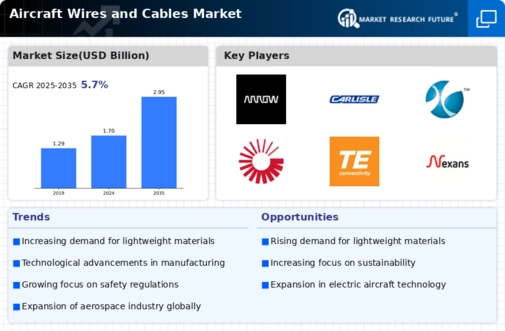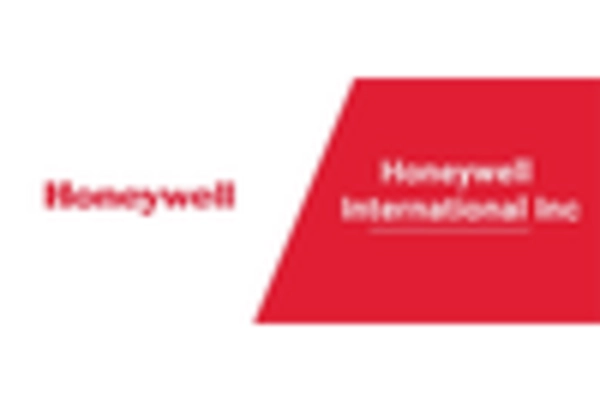-
Executive Summary
-
Market Attractiveness Analysis
- Global Aircraft Wires & Cables Market, by Type
- Global Aircraft Wires & Cables Market, by Fit
- Global Aircraft Wires & Cables Market, by Aircraft Type
- Global Aircraft Wires & Cables Market, by Application
- Global Aircraft Wires & Cables Market, by Region
-
Market Introduction
-
Market Definition
-
Scope of the Study
-
Market Structure
-
Key Buying Criteria
-
Market Factor Indicator Analysis
-
Research Methodology
-
Research Process
-
Primary Research
-
Secondary Research
-
Market Size Estimation
-
Forecast Model
-
List of Assumptions
-
Market Insights
-
Market Dynamics
-
Introduction
-
Drivers
-
Restraints
-
Opportunities
-
Challenges
-
Market/Technological Trends
-
Patent Trends
-
Regulatory Landscape/Standards
-
Market Factor Analysis
-
Value Chain/Supply Chain Analysis
- R&D
- Manufacturing
- Distribution & Sales
- Post-Sales Monitoring
-
Porter’s Five Forces Analysis
- Threat of New Entrants
- Bargaining Power of Buyers
- Threat of Substitutes
- Rivalry
- Bargaining Power of Supplies
-
Global Aircraft Wires & Cables Market, by Type
-
Introduction
-
Aircraft Wire
- Market Estimates & Forecast, 2022-2032
- Market Estimates & Forecast, by Region, 2022-2032
-
Aircraft Cable
- Market Estimates & Forecast, 2022-2032
- Market Estimates & Forecast, by Region, 2022-2032
-
Aircraft Harness
- Market Estimates & Forecast, 2022-2032
- Market Estimates & Forecast, by Region, 2022-2032
-
Global Aircraft Wires & Cables Market, by Fit
-
Introduction
-
Line-Fit
- Market Estimates & Forecast, 2022-2032
- Market Estimates & Forecast, by Region, 2022-2032
-
Retrofit
- Market Estimates & Forecast, 2022-2032
- Market Estimates & Forecast, by Region, 2022-2032
-
Global Aircraft Wires & Cables Market, by Aircraft Type
-
Introduction
-
Civil Aircraft
- Market Estimates & Forecast, 2022-2032
- Market Estimates & Forecast, by Region, 2022-2032
-
Military Aircraft
- Market Estimates & Forecast, 2022-2032
- Market Estimates & Forecast, by Region, 2022-2032
-
Global Aircraft Wires & Cables Market, by Application
-
Introduction
-
Lighting
- Market Estimates & Forecast, 2022-2032
- Market Estimates & Forecast, by Region, 2022-2032
-
Flight Control System
- Market Estimates & Forecast, 2022-2032
- Market Estimates & Forecast, by Region, 2022-2032
-
Power Transfer
- Market Estimates & Forecast, 2022-2032
- Market Estimates & Forecast, by Region, 2022-2032
-
Data Transfer
- Market Estimates & Forecast, 2022-2032
- Market Estimates & Forecast, by Region, 2022-2032
-
Avionics
- Market Estimates & Forecast, 2022-2032
- Market Estimates & Forecast, by Region, 2022-2032
-
Others
- Market Estimates & Forecast, 2022-2032
- Market Estimates & Forecast, by Region, 2022-2032
-
Global Aircraft Wires & Cables Market, by Region
-
Introduction
-
North America
- Market Estimates & Forecast, by Country, 2022-2032
- Market Estimates & Forecast, by Type, 2022-2032
- Market Estimates & Forecast, by Fit, 2022-2032
- Market Estimates & Forecast, by Aircraft Type, 2022-2032
- Market Estimates & Forecast, by Application, 2022-2032
- US
- Canada
-
Europe
- Market Estimates & Forecast, by Country, 2022-2032
- Market Estimates & Forecast, by Type, 2022-2032
- Market Estimates & Forecast, by Fit, 2022-2032
- Market Estimates & Forecast, by Aircraft Type, 2022-2032
- Market Estimates & Forecast, by Application, 2022-2032
- Italy
- Switzerland
- France
- Russia
- Rest of Europe
-
Asia-Pacific
- Market Estimates & Forecast, by Country, 2022-2032
- Market Estimates & Forecast, by Type, 2022-2032
- Market Estimates & Forecast, by Fit, 2022-2032
- Market Estimates & Forecast, by Aircraft Type, 2022-2032
- Market Estimates & Forecast, by Application, 2022-2032
- China
- Japan
- India
- South Korea
- Rest of Asia-Pacific
-
Middle East & Africa
- Market Estimates & Forecast, by Country, 2022-2032
- Market Estimates & Forecast, by Type, 2022-2032
- Market Estimates & Forecast, by Fit, 2022-2032
- Market Estimates & Forecast, by Aircraft Type, 2022-2032
- Market Estimates & Forecast, by Application, 2022-2032
- UAE
- Saudi Arabia
- Israel
- Africa
- Rest of the Middle East & Africa
-
Latin America
- Market Estimates & Forecast, by Country, 2022-2032
- Market Estimates & Forecast, by Type, 2022-2032
- Market Estimates & Forecast, by Fit, 2022-2032
- Market Estimates & Forecast, by Aircraft Type, 2022-2032
- Market Estimates & Forecast, by Application, 2022-2032
- Brazil
- Rest of Latin America
-
Competitive Landscape
-
Competitive Overview
-
Competitor Dashboard
-
Major Growth Strategies in the Global Aircraft Wires & Cables Market
-
Competitive Benchmarking
-
Market Share Analysis
-
PIC Wire & Cable: The Leading Player in Terms of Number of Developments in the Global Aircraft Wires & Cables Market
-
Key Developments & Growth Strategies
- Product Launches/Fit Deployments
- Mergers & Acquisitions
- Joint Ventures
-
Company Profiles
-
AMETEK, Inc.
- Company Overview
- Products/Fits Offered
- Financial Overview
- Key Developments
- SWOT Analysis
- Key Strategies
-
Amphenol Corporation
- Company Overview
- Products/Fits Offered
- Financial Overview
- Key Developments
- SWOT Analysis
- Key Strategies
-
Arrow Electronics, Inc.
- Company Overview
- Products/Fits Offered
- Financial Overview
- Key Developments
- SWOT Analysis
- Key Strategies
-
Carlisle Companies Inc.
- Company Overview
- Products/Fits Offered
- Financial Overview
- Key Developments
- SWOT Analysis
- Key Strategies
-
Collins Aerospace
- Company Overview
- Products/Fits Offered
- Financial Overview
- Key Developments
- SWOT Analysis
- Key Strategies
-
Leviton Manufacturing Co., Inc.
- Company Overview
- Products/Fits Offered
- Financial Overview
- Key Developments
- SWOT Analysis
- Key Strategies
-
NEXANS
- Company Overview
- Products/Fits Offered
- Financial Overview
- Key Developments
- SWOT Analysis
- Key Strategies
-
Radiall
- Company Overview
- Products/Fits Offered
- Financial Overview
- Key Developments
- SWOT Analysis
- Key Strategies
-
TE Connectivity
- Company Overview
- Products/Fits Offered
- Financial Overview
- Key Developments
- SWOT Analysis
- Key Strategies
-
The Angelus Corporation
- Company Overview
- Products/Fits Offered
- Financial Overview
- Key Developments
- SWOT Analysis
- Key Strategies
-
W.L. Gore & Associates, Inc.
- Company Overview
- Products/Fits Offered
- Financial Overview
- Key Developments
- SWOT Analysis
- Key Strategies
-
Appendix
-
References
-
Related Reports
-
List of Abbreviations
-
Industry Insights
-
Note: This table of contents is tentative and subject to change as the research progresses.
-
List of Tables
-
Global Aircraft Wires & Cables Market, by Region, 2022-2032
-
North America: Aircraft Wires & Cables Market, by Country, 2022-2032
-
Europe: Aircraft Wires & Cables Market, by Country, 2022-2032
-
Asia-Pacific: Aircraft Wires & Cables Market, by Country, 2022-2032
-
Middle East & Africa: Aircraft Wires & Cables Market, by Country, 2022-2032
-
Latin America: Aircraft Wires & Cables Market, by Country, 2022-2032
-
Global Aircraft Wires & Cables Market Size, by Region, 2022-2032
-
North America: Aircraft Wires & Cables Market Size, by Country, 2022-2032
-
Europe: Aircraft Wires & Cables Market Size, by Country, 2022-2032
-
Asia-Pacific: Aircraft Wires & Cables Market Size, by Country, 2022-2032
-
Middle East & Africa: Aircraft Wires & Cables Market Size, by Country, 2022-2032
-
Latin America: Aircraft Wires & Cables Market Size, by Country, 2022-2032
-
Global Aircraft Wires & Cables Type Market, by Region, 2022-2032
-
North America: Aircraft Wires & Cables Type Market, by Country, 2022-2032
-
Europe: Aircraft Wires & Cables Type Market, by Country, 2022-2032
-
Asia-Pacific: Aircraft Wires & Cables Type Market, by Country, 2022-2032
-
Middle East & Africa: Aircraft Wires & Cables Type Market, by Country, 2022-2032
-
Latin America: Aircraft Wires & Cables Type Market, by Country, 2022-2032
-
Global Aircraft Wires & Cables Fit Market, by Region, 2022-2032
-
North America: Aircraft Wires & Cables Fit Market, by Country, 2022-2032
-
Europe: Aircraft Wires & Cables Fit Market, by Country, 2022-2032
-
Asia-Pacific: Aircraft Wires & Cables Fit Market, by Country, 2022-2032
-
Middle East & Africa: Aircraft Wires & Cables Fit Market, by Country, 2022-2032
-
Latin America: Aircraft Wires & Cables Fit Market, by Country, 2022-2032
-
Global Aircraft Wires & Cables Aircraft Type Market, by Region, 2022-2032
-
North America: Aircraft Wires & Cables Aircraft Type Market, by Country, 2022-2032
-
Europe: Aircraft Wires & Cables Aircraft Type Market, by Country, 2022-2032
-
Asia-Pacific: Aircraft Wires & Cables Aircraft Type Market, by Country, 2022-2032
-
Middle East & Africa: Aircraft Wires & Cables Aircraft Type Market, by Country, 2022-2032
-
Latin America: Aircraft Wires & Cables Aircraft Type Market, by Country, 2022-2032
-
Global Aircraft Wires & Cables Application Market, by Region, 2022-2032
-
North America: Aircraft Wires & Cables Application Market, by Country, 2022-2032
-
Europe: Aircraft Wires & Cables Application Market, by Country, 2022-2032
-
Asia-Pacific: Aircraft Wires & Cables Application Market, by Country, 2022-2032
-
Middle East & Africa: Aircraft Wires & Cables Application Market, by Country, 2022-2032
-
Latin America: Aircraft Wires & Cables Application Market, by Country, 2022-2032
-
Global Aircraft Wires & Cables Market, by Region, 2022-2032
-
Global Aircraft Wires & Cables Market, by Type, 2022-2032
-
Global Aircraft Wires & Cables Market, by Fit, 2022-2032
-
Global Aircraft Wires & Cables Market, by Aircraft Type, 2022-2032
-
Global Aircraft Wires & Cables Market, by Application, 2022-2032
-
North America: Aircraft Wires & Cables Market, by Country, 2022-2032
-
North America: Aircraft Wires & Cables Market, by Type, 2022-2032
-
North America: Aircraft Wires & Cables Market, by Fit, 2022-2032
-
North America: Aircraft Wires & Cables Market, by Aircraft Type, 2022-2032
-
North America: Aircraft Wires & Cables Market, by Application, 2022-2032
-
Europe: Aircraft Wires & Cables Market, by Country, 2022-2032
-
Europe: Aircraft Wires & Cables Market, by Type, 2022-2032
-
Europe: Aircraft Wires & Cables Market, by Fit, 2022-2032
-
Europe: Aircraft Wires & Cables Market, by Aircraft Type, 2022-2032
-
Europe: Aircraft Wires & Cables Market, by Application, 2022-2032
-
Asia-Pacific: Aircraft Wires & Cables Market, by Country, 2022-2032
-
Asia-Pacific: Aircraft Wires & Cables Market, by Type, 2022-2032
-
Asia-Pacific: Aircraft Wires & Cables Market, by Fit, 2022-2032
-
Asia-Pacific: Aircraft Wires & Cables Market, by Aircraft Type, 2022-2032
-
Asia-Pacific: Aircraft Wires & Cables Market, by Application, 2022-2032
-
Middle East & Africa: Aircraft Wires & Cables Market, by Country, 2022-2032
-
Middle East & Africa: Aircraft Wires & Cables Market, by Type, 2022-2032
-
Middle East & Africa: Aircraft Wires & Cables Market, by Fit, 2022-2032
-
Middle East & Africa: Aircraft Wires & Cables Market, by Aircraft Type, 2022-2032
-
Middle East & Africa: Aircraft Wires & Cables Market, by Application, 2022-2032
-
Latin America: Aircraft Wires & Cables Market, by Country, 2022-2032
-
Latin America: Aircraft Wires & Cables Market, by Type, 2022-2032
-
Latin America: Aircraft Wires & Cables Market, by Fit, 2022-2032
-
Latin America: Aircraft Wires & Cables Market, by Aircraft Type, 2022-2032
-
Latin America: Aircraft Wires & Cables Market, by Application, 2022-2032
-
-
List of Figures
-
Research Process of MRFR
-
Top-Down & Bottom-Up Approaches
-
Market Dynamics
-
Impact Analysis: Market Drivers
-
Impact Analysis: Market Restraints
-
Porter's Five Forces Analysis
-
Value Chain Analysis
-
Global Aircraft Wires & Cables Market Share, by Type, 2020 (%)
-
Global Aircraft Wires & Cables Market, by Type, 2022-2032 (USD Million)
-
Global Aircraft Wires & Cables Market Share, by Fit, 2020 (%)
-
Global Aircraft Wires & Cables Market, by Fit, 2022-2032 (USD Million)
-
Global Aircraft Wires & Cables Market Share, by Aircraft Type, 2020 (%)
-
Global Aircraft Wires & Cables Market, by Aircraft Type, 2022-2032 (USD Million)
-
Global Aircraft Wires & Cables Market Share, by Application, 2020 (%)
-
Global Aircraft Wires & Cables Market, by Application, 2022-2032 (USD Million)
-
Global Aircraft Wires & Cables Market Share (%), by Region, 2020
-
Global Aircraft Wires & Cables Market, by Region, 2022-2032 (USD Million)
-
North America: Aircraft Wires & Cables Market Share (%), 2020
-
North America: Aircraft Wires & Cables Market, by Country, 2022-2032 (USD Million)
-
Europe: Aircraft Wires & Cables Market Share (%), 2020
-
Europe: Aircraft Wires & Cables Market, by Country, 2022-2032 (USD Million)
-
Asia-Pacific: Aircraft Wires & Cables Market Share (%), 2020
-
Asia-Pacific: Aircraft Wires & Cables Market, by Country, 2022-2032 (USD Million)
-
Middle East & Africa: Aircraft Wires & Cables Market Share (%), 2020
-
Middle East & Africa: Aircraft Wires & Cables Market, by Region, 2022-2032 (USD Million)
-
Latin America: Aircraft Wires & Cables Market Share (%), 2020
-
Latin America: Aircraft Wires & Cables Market, by Region, 2022-2032 (USD Million)

















Leave a Comment